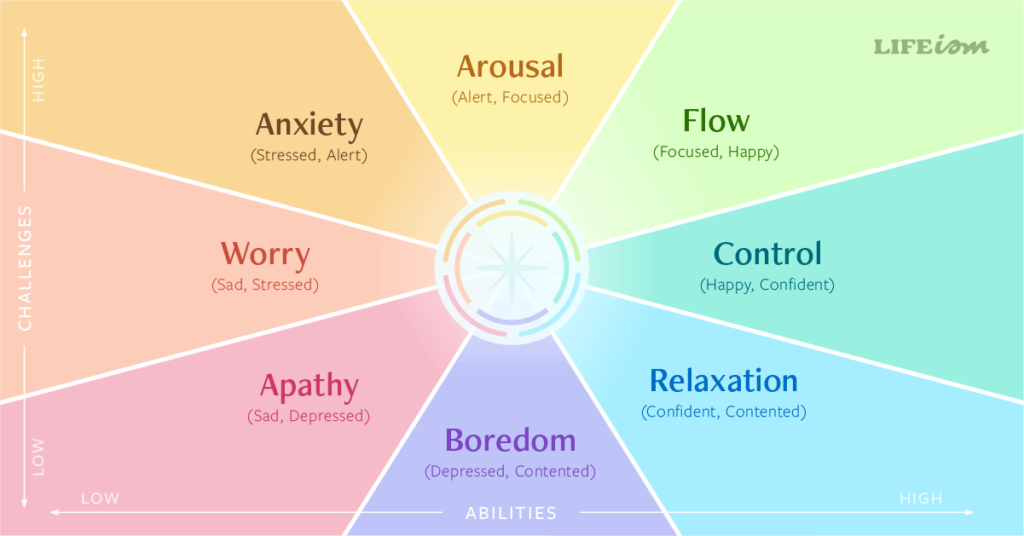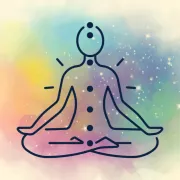Understanding the State of Flow
The state of flow is studied by many psychologists and touted as a powerful indicator of overall wellbeing. So, what is the state of flow? Let’s dive deeper.

We’ve heard the term far too many times, but how many of us really know its true meaning? In its essence, a flow could be simplified as ‘being in the zone.’ If you’ve ever experienced an unmoving focus towards a task, truly absorbed by it, you’ve probably experienced the state of flow.
In this state of mind, you feel completely present in a moment, utterly engrossed in so much so that you might lose the sense of time of the sense of self; but feel relaxed, fulfilled, and tranquil when you come out of it.
Creative activities like dancing, painting, playing music, running, are some ways to feel this state of flow. Runners' high is another commonly used term to explain this state. When we’re running, our entire concentration is on our breath, our feet hitting the ground, and our body moving through distance. We feel fixated on this movement, and our sole focus is on our next step, next breath. This then leads to a sense of calm and a rush that enthralls us.
When we experience flow, we are in our optimal state of consciousness. We feel our best and perform our best. We are so focused on the task at hand that everything else disappears. Action and awareness merge, and our mental and physical performance goes up.
Various studies have found that an altered state of consciousness leads to peak human performance. Mihaly Csikszentmihalyi (also known as the father of flow), in his popular book, Flow: The Psychology of Optimal Experience (1990) stated that happiness is a transitionary state and can be trained as we learn to achieve flow in our lives.
Here are five things about flow that will help in better understanding it:
- Flow is definable. It is also measurable and can be developed with practice. Being in the state of flow has many advantages. Here are the top three experiences when you are in a flow state: a) Uninterrupted concentration b) Time dilatation and c) Loss of bodily awareness.
- It’s a spectrum experience. For instance, just like we can be a little hurt or we can be very angry, flow state is also experienced as a spectrum. We can be in a super-charged flow state or in a lower flow state. This spectrum can broadly be defined in two ways: a) Micro flow – some of the flow conditions show up in our experience. and b) Macro flow — all of the condition of flow shows up in our experience.
- State of flow is more than a feeling. While all of us talk about how we feel when we are in a state of flow, in reality, it's just near perfect high-speed decision-making happening successively. Notice that we said near perfect. Which means that we can make errors in the state of flow.
- Flow is universal. It shows up in anyone anywhere provided certain conditions are met. These conditions are called flow triggers. We will talk about flow triggers in just a little bit. But the important thing to remember is that anyone can achieve that state of flow and it is not just teachable but also repeatable with practice.
- Flow is essential. There is a lot of research that indicates that if you want overall wellbeing in life and want to live a meaningful life that is not stressful, the state of flow is quintessential. It lets you take risks, makes you productive, and helps you focus.
How optimal is flow?
Flow accounts for major breakthroughs in science, arts, sports, and business. Top executives were studied for 10 years at McKinsey. Those who were in the state of flow were found to be 5X more productive in flow than those out of the flow. So, by practicing regularly and honing on this skill, just spending 2 days a week in the state of flow can make us 1000% more productive.
Where is flow coming from?
Okay, now that we get the basics of flow, let's get into the details. We already know that flow can be achieved by anyone. We also know that it requires practice like any other skill. However, there are actual biomarkers that we know of that indicate that we are in the state of flow. They also tell us which techniques work for us, and which ones will be more effective over time. Let's dive a little deeper into science.
- Neural Anatomy: When we are in a state of flow, we use less of our brain, specifically our prefrontal cortex. This phenomenon is known as Transient Hypo-Frontality. The performance of the prefrontal cortex reduces significantly when we are in a state of flow. Our pre-frontal cortex is responsible for helping us perceive the passage of time. So, when our prefrontal cortex reduces its activity, we feel like there is no passage of time. Hours pass by and like minutes. We even lose the ability to distinguish between past, present, and future. It also tends to neutralize our worries about the past and the future. It firmly grounds us in the present.
This also means that our stress hormones plummet and we are no longer triggered. Our prefrontal cortex is not constantly reminding us of things we need to do or things we did wrong.
The same thing happens to our sense of self – what psychologists often refer to as ego. We lose all judgments about ourselves in the state of flow. Even that nagging self-critic or what some call the “voice” is silenced.
The combination of these few experiences coming together makes us feel liberated. Our creativity skyrockets, we feel energized and are capable of taking more risks since the feelings of anxiety and stress are subdued when we are in a state of flow.
- Network: Our CNS or Central Nervous System is active and constantly sending neural messages across the body. When we are in the state of flow, this default network mode is knocked out. This network is the center for self-critical thoughts, unconstructive thoughts. When we are in flow, this network quietens down and allows us to be creative and full of vitality.
- Brainwaves: In a normal awake state, our brains are in a beta wave state. A slower wave is alpha which is identified as the day-dreaming wave. Below that is theta wave. This is where you are right before falling asleep. Flow takes you between alpha and theta. In this stage, it's easy to produce gamma waves. Gamma waves are what help us form distinct and often far-fetched connections. When gamma rays are present, we are able to link our thoughts to each other seamlessly and form connections that solve larger problems. In fact, the ‘aha’ moment often takes place when gamma waves are present.
The state of Flow pushes our thoughts right to the edge of breakthroughs and new discoveries, which would otherwise be buried in our conscious state.
- Neural Chemistry: When we are in flow, we produce 5 of the most important neural chemicals in our brain: Norepinephrine, Dopamine, Serotonin, Anandamide, and Endorphins. These chemicals are responsible for a lot of distinct functions overall and have a significant impact on our physical and mental performance.
- Norepinephrine and Dopamine are the chemicals that aid in focus or concentration. When they are in our system, our concentration heightens. They are normally released for 20 minutes and that’s usually the brains' attention span.
- Serotonin is a pro-social chemical. It has a calming effect and makes us capable of facing challenges at hand by increasing social awareness and response.
- Anandamide is like a pain killer. It dampens our sensitivity to pain and amps up lateral thinking. It helps the brain to connect far-fetched ideas.
- Endorphins are the pleasure drivers and really make us feel good. It produces a sense of euphoria and sparks joy in our brains.
The high-performance triangle — Impact of These Chemicals
Being in a state of flow has numerous benefits on our mental and physical wellbeing. Since these chemicals govern our intellect and emotional response, learning how to alter them in a balanced way can provide significant benefits. These chemicals have their biggest impact on us when we are in a state of flow.

- Motivation: The chemicals are pleasure drugs. And flow is the only time when all 5 of them are released at the same time. Production of these 5 chemicals can feel like euphoria. This feeling when we are in a state of flow is incomparable.
To give you a sense of how powerful these are, let's walk through an example. Have you experienced the bliss of falling in love? When everything is right in the world, and nothing seems to bother you? When you are falling in love for the first time, just 2 of the 5 chemicals are produced in your brain. Just two. Imagine what it feels like when all 5 are produced. This is powerful chemistry.
- Impact on learning and memory: The more these neural chemicals are induced in our brain the longer their impact lasts on us. We’ve all heard that to learn a new skill, we need 10,000 hours of practice. But studies show that when we learn something in the flow state, it cuts that time in half. With daily practice of being in flow, our brains can develop the power to absorb new information and pick up new skills faster than ever.
- Creativity: When we are in a state of flow, all the mental processes involved in creativity are in hyperdrive due to these 5 chemicals being simultaneously produced in our brain. Flow amplifies a level of imaginative creation. It allows us to take in more information, pay more attention, make faster connections, improve our pattern recognition and heightens lateral thinking; thus, shooting up our creative instincts by 400 to 700 percent in the flow state. Creativity is not just about having that idea but also taking the risk to see it through. During flow, our capacity for risk-taking increases, because we are not worried or stressed about the consequences or outcomes. Instead, we are a hundred percent engrossed in the process.
Flow Triggers
So all of this information is great, knowing how your brain works, why flow is more productive and blissful, etc. But what triggers that state of flow?
In his most recent book, Rise of the Superman, American author, journalist, and renowned human performance researcher, Steven Kotler, undertook Csikszentmihalyi’s ideas and explained that the triggers or components of achieving flow can be broken into 17 categories. You can read more about Steve’s research here. Here are the 4 basic ways under which these 17 components are classified.
- Psychological Triggers: These are triggers that bring your attention to the present moment. The flow requires undivided attention to a task. Some ways to trigger flow psychologically are to set time aside to just pay attention to a singular task at hand, have a clear goal for it in your mind before you begin, ensure that the task is neither too challenging nor too mundane since Flow occurs at the perfect balance of excitement and boredom.
- Environmental Triggers: These are factors from the environment around us that can trigger a state of flow. Certain situations such as the ones that involve a risk can drive us into the flow. This is because, in an unpredictable scenario, we tend to pay close attention to the task we have at hand. For example, driving a vehicle. Tasks that involve multiple senses to work in harmony can put us into a state of flow like mountain climbing requires strength to climb while paying attention to our balance and acute concentration to predict any danger or misstep.
- Social Triggers: These triggers are practiced by a group of individuals and are factors that alter social conditions to produce flow for the group. During group flows, a group of like-minded individuals that share common interests focuses on a singular task, with undivided attention, while exchanging their thoughts in a constructive conversation.
- Creative Triggers: Certain components of creativity are significant triggers of flow. Like pattern recognition to identify and link new ideas and risk-taking to achieve goals.
In our next article on Flow Triggers, we will dive deeper to understand how the state of flow is actually triggered in each of us. However, we can all agree that the experience of flow in everyday life is an important part of happiness, creativity, productivity, and overall well-being. It is also termed as one of the key aspects of eudaimonia, or the overall welfare of an individual. With consistent practice, it can become easier to attain the state of flow and reap its rewards and get a step closer to leading a happy, fulfilled life.








Comments
I find myself in the flow regularly, having read this blog I now understand what be occurring when I'm in this state. Thanks
I actually resonated with whatever you have written, very insightful blog